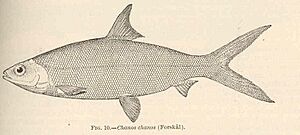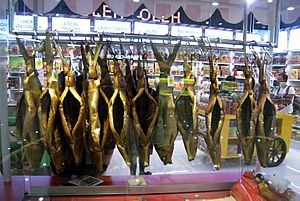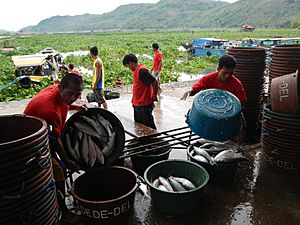Milkfish facts for kids
Quick facts for kids MilkfishTemporal range: Early Cretaceous–present
|
|
|---|---|
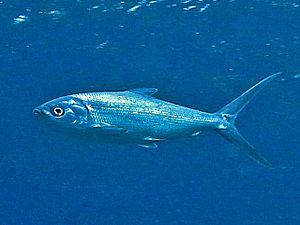 |
|
| Chanos chanos from French Polynesia | |
 |
|
| Chanos chanos (locally called bangús) in a Philippine fish market | |
| Conservation status | |
| Scientific classification | |
| Genus: |
Chanos
|
| Species: |
chanos
|
| Synonyms | |
|
|
The milkfish (Chanos chanos) is a type of fish that is the only living species in its special fish family, called Chanidae. This means it's the only one of its kind left from a very old group of fish! There were at least five other types of fish in this family that are now extinct. They lived a long, long time ago, during the Cretaceous period.
This fish has many different names around the world. In Hawaii, it's called awa, and in Tahiti, it's ava. People in the Philippines call it bangús. It's very popular there and is often thought of as the country's national fish. However, the government has said this isn't officially true. In the Nauruan language, it's known as ibiya. In Indonesia, you might hear it called bandeng or bolu.
Milkfish live in the warm waters of the Indian Ocean and across the Pacific Ocean. You can find them from South Africa all the way to Hawaii and the Marquesas Islands. They also live from California to the Galapagos Islands, north to Japan, and south to Australia. These fish usually live in tropical ocean waters near islands and along the edges of continents. They prefer depths of about 1 to 30 meters (3 to 98 feet). They also often swim into estuaries (where rivers meet the sea) and even up into rivers.
Contents
Milkfish Body Features
Milkfish can grow quite large, up to about 1.8 meters (6 feet) long. But usually, they are closer to 1 meter (3 feet) long. They can weigh around 14 kilograms (31 pounds) and live for up to 15 years. Their bodies are long and a bit flat from side to side. They look very smooth and streamlined, which helps them swim fast.
They have one fin on their back (dorsal fin) and two large, curved fins on their sides (pectoral fins). Their tail fin is big and forked, like a "V" shape. Milkfish have a small mouth and no teeth. Their bodies are olive green on top, with shiny silver sides and fins that have dark edges.
Milkfish Life and Habits
These fish mostly eat algae (tiny plant-like organisms) and small invertebrates (animals without backbones). They like to swim together in large groups, called schools. You can often find these schools near coasts and islands where there are coral reefs.
Milkfish Life Cycle and Reproduction
Young milkfish, called fry, spend about two to three weeks living in the open sea. After this, they move to places like mangrove swamps, estuaries, and sometimes even lakes. They stay there during their juvenile stage, growing bigger. Once they are old enough to reproduce, they return to the sea. Female milkfish lay up to 5 million eggs at night in shallow, salty waters.
Milkfish as Food
Milkfish is a very important food in Southeast Asia and some Pacific Islands. It's known for having many small bones, which can make it tricky to eat. Because of this, "boneless bangús" has become very popular in the Philippines. This is milkfish where the bones have been carefully removed. Even with the bones, many people in the Philippines love to eat milkfish cooked in different ways. They also eat it raw, mixed with kalamansi juice or vinegar, in a dish called kinilaw na bangus.
In Indonesia, popular ways to prepare milkfish include bandeng duri lunak. This means the fish is pressure cooked until its bones become soft and easy to eat. Another popular dish is bandeng asap, which is smoked milkfish. Whether fresh or processed, milkfish is a favorite seafood product in Indonesian fishing towns like Juwana and Sidoarjo.
Milkfish is also the most popular fish in Taiwanese cuisine. People value it because it's so versatile, has tender meat, and is affordable. You can find it as a topping for congee (a type of rice porridge), pan-fried, braised, or made into fish balls. There's even a milkfish museum in Anping District, and the city of Kaohsiung holds a yearly milkfish festival!
Milkfish Farming
History of Milkfish Farming
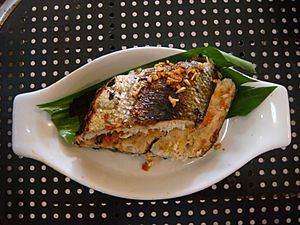
People started farming milkfish about 1800 years ago in the Philippines. This practice then spread to Indonesia, Taiwan, and other parts of the Pacific. In the past, farmers would collect wild young fish (fry) to stock their ponds. This meant the number and quality of fish could change a lot depending on the season and location.
In the late 1970s, farmers successfully got breeding milkfish to lay eggs. But these fish were hard to find, and their eggs weren't always reliable. Then, in 1980, milkfish started laying eggs on their own in sea cages. These eggs provided enough young fish for farms to have a steady supply.
How Milkfish Are Farmed
Young milkfish (fry) are raised in different ways. They can be grown in sea cages, large salty ponds (especially in the Philippines), or concrete tanks (in Indonesia and Taiwan). Milkfish become ready to reproduce when they weigh about 1.5 kilograms (3.3 pounds). This takes about five years in floating sea cages, but eight to ten years in ponds and tanks.
Once they weigh about 6 kilograms (13 pounds), which takes around eight years, they can produce 3 to 4 million eggs each time they breed. Farmers usually rely on natural signals from the environment to encourage breeding. However, some try to make them breed using special hormones. Some still use the old method of catching wild fry with nets.
Milkfish hatcheries, where the eggs hatch, have different types of tiny living things. These include rotifers, green algae, and brine shrimp, which are food for the young fish. Hatcheries can be either intensive (very controlled) or semi-intensive (less controlled). Semi-intensive methods were more profitable in 1998, costing less per thousand young fish. However, they require more skilled workers.
Nurseries for milkfish in Taiwan are very commercial, with many fish packed into small spaces. Indonesia has similar numbers, but often has smaller, backyard-style nurseries. In the Philippines, nurseries are often part of larger farms where the fish are grown to full size.
There are three main ways to grow milkfish:
- Pond Culture: This is common in Indonesia and the Philippines. These ponds are shallow (30-40 cm or about 1 foot deep) and have brackish water (a mix of fresh and salt water). They often have algae growing on the bottom, which the fish eat. These ponds are usually dug out of areas with nipa palms or mangroves.
- Pen Culture: This method was started in 1979 in a lake called Laguna de Bay. The lake had a lot of natural food for the fish. When the natural food ran out, farmers added fertilizer. However, fish in pens can get sick more easily.
- Cage Culture: This involves large cages placed in open coastal bays. The fish in these cages mostly eat natural food found in the water.
Most of the food for milkfish is natural, like lab-lab (a mix of tiny plants and animals) or a combination of phytoplankton (tiny water plants) and macroalgae (larger seaweeds). In the past, farmers made this food themselves. Now, it's often made commercially and delivered.
Fish are harvested when they are about 20–40 cm (8–16 inches) long, weighing 250–500 grams (0.5–1.1 pounds). Sometimes, only fish of a certain size are removed using nets. Other times, all the fish are harvested at once, leading to different sizes. If there's an environmental problem, like not enough oxygen in the water, all the fish might be harvested quickly.
Milkfish can sometimes get parasites like nematodes (roundworms), copepods (tiny crustaceans), protozoa (single-celled organisms), and helminths (worms). Many of these can be treated with chemicals and antibiotics.
Preparing and Selling Milkfish
After milkfish are harvested, they are traditionally prepared by smoking, drying, or fermenting them. More recently, people have started bottling, canning, and freezing milkfish.
The demand for milkfish has been growing steadily since 1950. In 2005, about 595,000 tonnes (about 656,000 tons) of milkfish were harvested, worth about US$616 million.
There's a growing trend to make milkfish into "value-added" products, which means preparing them in special ways to make them more appealing or convenient. Recently, people have also started looking into using young milkfish as bait for catching tuna with long lines. This could open up new markets for farms that raise young milkfish.
The Golden Milkfish
On April 21, 2012, a fisherman in the Philippines found a milkfish with a rare yellowish color. He gave it to the Philippine Bureau of Fisheries and Aquatic Resources, and it was later called the "golden bangus". Sadly, the fish soon died. It's believed this happened because the pond it was moved to had too little oxygen.
Images for kids
-
Fried milkfish belly fillet served at restaurant in Taipei, Taiwan.
See also
 In Spanish: Sabalote para niños
In Spanish: Sabalote para niños



